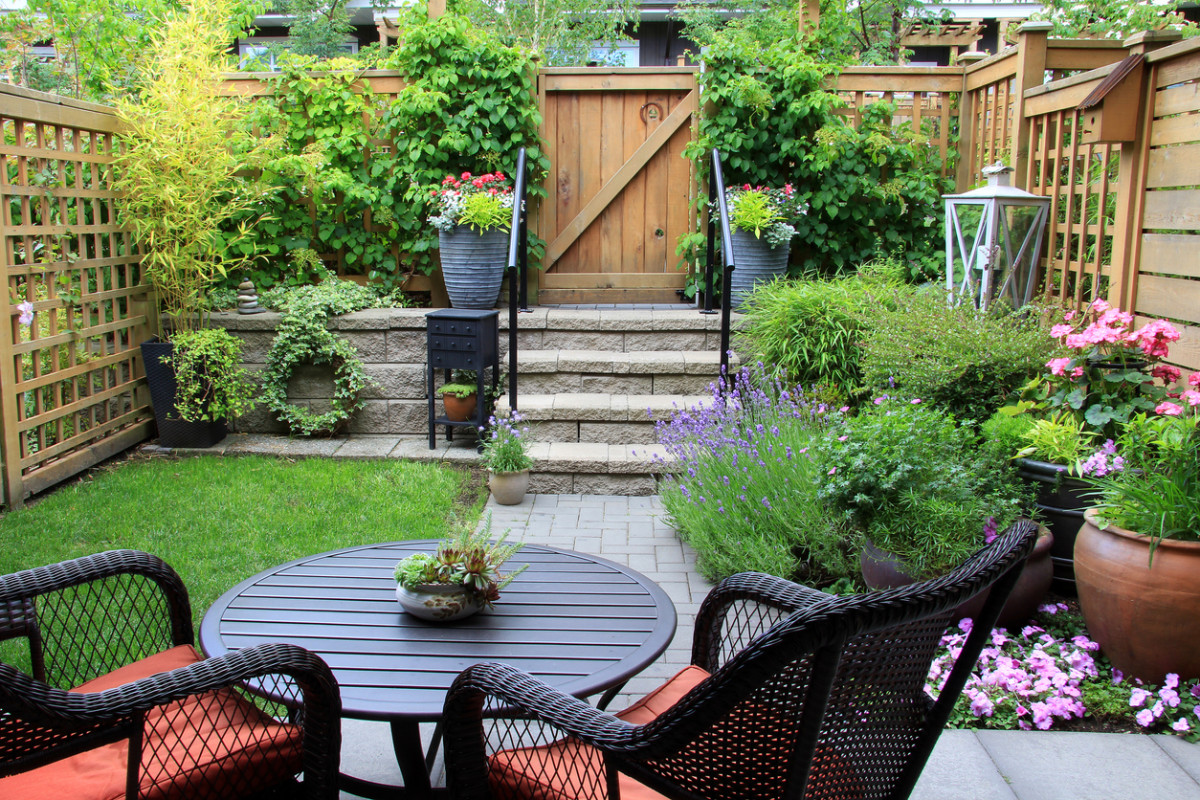Home Improvement
Transforming Your Outdoor Space: Tips for a Stunning Garden
Published
10 months agoon
By
James flick
Table of Contents
- Choosing the Right Plants
- Incorporating Water Features
- Outdoor Furniture and Décor
- Sustainable Gardening Practices
- Lighting Your Garden
- Designing for Small Spaces
Choosing the Right Plants
One of the most essential aspects of creating a beautiful garden is selecting the right plants. With an online plant nursery, you have access to a wide variety of plants that can cater to your specific gardening conditions. Consider your local climate and soil type before choosing your greenery. For example, native plants are well-adapted to local conditions and can thrive with minimal care. Gardening experts often recommend a mix of perennials and annuals to ensure year-round interest.
When selecting plants, it’s also important to think about their growth habits and how they will coexist in your garden layout. Growing some plants alongside one another for mutual benefit is known as companion planting, and it can be a very wise move. Not only does this enhance the aesthetic appeal, but it also improves plant health and reduces pest issues. For instance, marigolds are known to repel certain pests when planted alongside vegetables like tomatoes.
Additionally, ensure that your chosen plants have similar water, sunlight, and soil requirements. This uniformity greatly simplifies garden care and increases your plants’ health and longevity. Consider utilizing raised beds or containers to better control soil conditions, especially if your garden area is prone to poor soil quality.
Incorporating Water Features
Your garden‘s peace and beauty can be greatly increased by adding a water feature, like a pond or fountain. Not only do water features create a focal point, but they also attract wildlife, providing a habitat for birds and beneficial insects. Make sure to choose a style that complements the overall design of your garden.
Water features don’t have to be elaborated on to have a significant impact. A tiny birdbath or a straightforward bubbling fountain can add a peaceful aspect to your area. However, for those with more room and a penchant for the extraordinary, consider installing a pond with aquatic plants and colorful fish. Ensure that any water feature you install is easy to maintain and fits well within your garden’s scale.
There are plenty of resources available to guide you on how to integrate these elements seamlessly. Whether you opt for a DIY approach or hire professionals, the calming effect of water in your garden is undeniable. To keep the water feature low-maintenance, consider using recirculating pumps and filtration systems that keep the water clean and reduce the need for frequent refills.
Outdoor Furniture and Decor
Your garden can become a useful living area with the help of outdoor furniture and garden décor. Opt for durable materials like teak or metal that can withstand the elements. Adding personal touches, such as garden art or colorful cushions, can also create a welcoming atmosphere.
When choosing outdoor furniture, think about the various activities you plan to enjoy in your garden. Comfortable seating for relaxation, a dining set for al fresco meals, and cozy nooks for reading or meditating can all contribute to a versatile and inviting garden space. Don’t forget to consider storage solutions for garden tools and outdoor accessories.
Your furniture’s color scheme and style can also influence the garden’s ambiance. Earthy tones can blend seamlessly with natural surroundings, while bold colors can add vibrancy and visual interest. Lighting options, like lanterns and string lights, can enhance the setting, making it perfect for evening gatherings.
Sustainable Gardening Practices
Practicing sustainable gardening not only benefits the environment but can also reduce maintenance efforts. Techniques like composting, rainwater harvesting, and using organic fertilizers are excellent ways to keep your garden healthy and eco-friendly. The EPA provides valuable tips on how to minimize stormwater pollution in gardens.
Mulching is another sustainable technique that promotes soil health, weed control, and moisture retention. Incorporating native plants and drought-tolerant species can further reduce water usage and enhance the resilience of your garden. Composting kitchen scraps and garden waste can provide a rich, natural fertilizer to nourish your plants.
In addition to these techniques, consider integrating permaculture principles into your garden design. This involves creating a self-sustaining ecosystem that mimics the natural environment. It includes crop rotation, polyculture, and using plants with symbiotic relationships to enhance biodiversity and productivity.
Lighting Your Garden
Proper garden lighting can extend the enjoyment of your outdoor space into the evening hours. Consider using solar lights for an eco-friendly option or string lights for a festive feel. Well-placed lighting can highlight key areas in your garden and improve safety as well.
Think about different types of lighting for various functions: ambient lighting for overall illumination, task lighting for specific activities like grilling, and accent lighting to highlight features. The right combination can create a magical atmosphere and make your garden a night-time retreat.
Pathway lights, spotlights, and uplights can be strategically placed to enhance specific elements of your garden, such as a beautiful tree or a serene water feature. Lanterns and candles can also add a warm, inviting glow, perfect for cozy evenings spent outdoors.
Designing for Small Spaces
You can still create a stunning garden even if you have limited outdoor space. Vertical gardening techniques, such as wall planters or trellises, can maximize your space. Choose compact plants and opt for multi-functional furniture to make the most of every square foot.
Small spaces can benefit from strategic design elements such as mirrors to reflect light and create an illusion of more space. Potted plants and hanging baskets can also add layers and depth to a small garden, making it feel lush and inviting.
Opt for a minimalist approach to avoid overcrowding. Focus on fewer, high-impact elements rather than trying to fit too many things into a limited area. Utilize portable furniture that can be easily rearranged to suit different occasions and incorporate storage solutions to keep the space organized and clutter-free.
Table of Contents
- Choosing the Right Plants
- Incorporating Water Features
- Outdoor Furniture and Décor
- Sustainable Gardening Practices
- Lighting Your Garden
- Designing for Small Spaces
Choosing the Right Plants
One of the most essential aspects of creating a beautiful garden is selecting the right plants. With an online plant nursery, you have access to a wide variety of plants that can cater to your specific gardening conditions. Consider your local climate and soil type before choosing your greenery. For example, native plants are well-adapted to local conditions and can thrive with minimal care. Gardening experts often recommend a mix of perennials and annuals to ensure year-round interest.
When selecting plants, it’s also important to think about their growth habits and how they will coexist in your garden layout. Growing some plants alongside one another for mutual benefit is known as companion planting, and it can be a very wise move. Not only does this enhance the aesthetic appeal, but it also improves plant health and reduces pest issues. For instance, marigolds are known to repel certain pests when planted alongside vegetables like tomatoes.
Additionally, ensure that your chosen plants have similar water, sunlight, and soil requirements. This uniformity greatly simplifies garden care and increases your plants’ health and longevity. Consider utilizing raised beds or containers to better control soil conditions, especially if your garden area is prone to poor soil quality.
Incorporating Water Features
Your garden’s peace and beauty can be greatly increased by adding a water feature, like a pond or fountain. Not only do water features create a focal point, but they also attract wildlife, providing a habitat for birds and beneficial insects. Make sure to choose a style that complements the overall design of your garden.
Water features don’t have to be elaborated on to have a significant impact. A tiny birdbath or a straightforward bubbling fountain can add a peaceful aspect to your area. However, for those with more room and a penchant for the extraordinary, consider installing a pond with aquatic plants and colorful fish. Ensure that any water feature you install is easy to maintain and fits well within your garden’s scale.
There are plenty of resources available to guide you on how to integrate these elements seamlessly. Whether you opt for a DIY approach or hire professionals, the calming effect of water in your garden is undeniable. To keep the water feature low-maintenance, consider using recirculating pumps and filtration systems that keep the water clean and reduce the need for frequent refills.
Outdoor Furniture and Decor
Your garden can become a useful living area with the help of outdoor furniture and garden décor. Opt for durable materials like teak or metal that can withstand the elements. Adding personal touches, such as garden art or colorful cushions, can also create a welcoming atmosphere.
When choosing outdoor furniture, think about the various activities you plan to enjoy in your garden. Comfortable seating for relaxation, a dining set for al fresco meals, and cozy nooks for reading or meditating can all contribute to a versatile and inviting garden space. Don’t forget to consider storage solutions for garden tools and outdoor accessories.
Your furniture’s color scheme and style can also influence the garden’s ambiance. Earthy tones can blend seamlessly with natural surroundings, while bold colors can add vibrancy and visual interest. Lighting options, like lanterns and string lights, can enhance the setting, making it perfect for evening gatherings.
Sustainable Gardening Practices
Practicing sustainable gardening not only benefits the environment but can also reduce maintenance efforts. Techniques like composting, rainwater harvesting, and using organic fertilizers are excellent ways to keep your garden healthy and eco-friendly. The EPA provides valuable tips on how to minimize stormwater pollution in gardens.
Mulching is another sustainable technique that promotes soil health, weed control, and moisture retention. Incorporating native plants and drought-tolerant species can further reduce water usage and enhance the resilience of your garden. Composting kitchen scraps and garden waste can provide a rich, natural fertilizer to nourish your plants.
In addition to these techniques, consider integrating permaculture principles into your garden design. This involves creating a self-sustaining ecosystem that mimics the natural environment. It includes crop rotation, polyculture, and using plants with symbiotic relationships to enhance biodiversity and productivity.
Lighting Your Garden
Proper garden lighting can extend the enjoyment of your outdoor space into the evening hours. Consider using solar lights for an eco-friendly option or string lights for a festive feel. Well-placed lighting can highlight key areas in your garden and improve safety as well.
Think about different types of lighting for various functions: ambient lighting for overall illumination, task lighting for specific activities like grilling, and accent lighting to highlight features. The right combination can create a magical atmosphere and make your garden a night-time retreat.
Pathway lights, spotlights, and uplights can be strategically placed to enhance specific elements of your garden, such as a beautiful tree or a serene water feature. Lanterns and candles can also add a warm, inviting glow, perfect for cozy evenings spent outdoors.
Designing for Small Spaces
You can still create a stunning garden even if you have limited outdoor space. Vertical gardening techniques, such as wall planters or trellises, can maximize your space. Choose compact plants and opt for multi-functional furniture to make the most of every square foot.
Small spaces can benefit from strategic design elements such as mirrors to reflect light and create an illusion of more space. Potted plants and hanging baskets can also add layers and depth to a small garden, making it feel lush and inviting.
Opt for a minimalist approach to avoid overcrowding. Focus on fewer, high-impact elements rather than trying to fit too many things into a limited area. Utilize portable furniture that can be easily rearranged to suit different occasions and incorporate storage solutions to keep the space organized and clutter-free.
